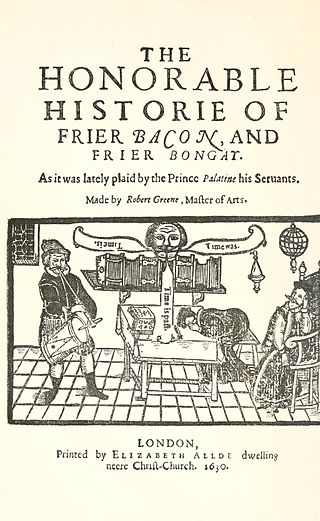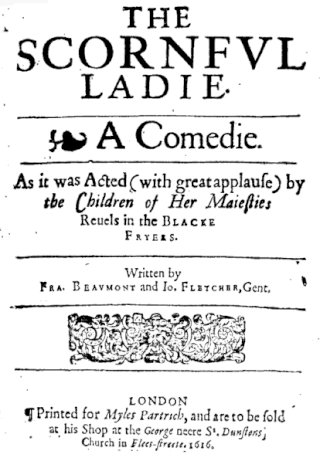Related Research Articles

John Ford was an English playwright and poet of the Jacobean and Caroline eras born in Ilsington in Devon, England. His plays deal mainly with the conflict between passion and conscience. Although remembered primarily as a playwright, he also wrote a number of poems on themes of love and morality.

Blurt, Master Constable, or the Spaniards' Night Walk is a late Elizabethan comedy, printed anonymously in 1602 and usually attributed to either Thomas Middleton or Thomas Dekker.

Friar Bacon and Friar Bungay, originally entitled The Honorable Historie of Frier Bacon and Frier Bongay, is an Elizabethan era stage play, a comedy written by Robert Greene. Widely regarded as Greene's best and most significant play, it has received more critical attention than any other of Greene's dramas.
Cupid's Revenge is a Jacobean tragedy written by Francis Beaumont and John Fletcher. It was a popular success that influenced subsequent works by other authors.

The Coronation Triumph is a Jacobean era literary work, usually classed as an "entertainment," written by Ben Jonson for the coronation of King James I and performed on 15 March 1604. Jonson's work was half of a total performance, the other half written by Thomas Dekker. The work was especially significant in the developing literary career of Jonson, in that it marked the commencement of his role as a writer of masques and entertainments for the Stuart Court, a role he would fill for the next three decades.
The Renegado, or The Gentleman of Venice is a late Jacobean stage play, a tragicomedy written by Philip Massinger and first published in 1630. The play has attracted critical attention for its treatment of cultural conflict between Christian Europe and Muslim North Africa.

The Scornful Lady is a Jacobean era stage play, a comedy written by Francis Beaumont and John Fletcher, and first published in 1616, the year of Beaumont's death. It was one of the pair's most popular, often revived, and frequently reprinted works.

Love's Metamorphosis is an Elizabethan era stage play, an allegorical pastoral written by John Lyly. It was the last of his dramas to be printed.
Summer's Last Will and Testament is an Elizabethan stage play, a comedy written by Thomas Nashe. The play is notable for breaking new ground in the development of English Renaissance drama. The literary scholar George Richard Hibbard says "No earlier English comedy has anything like the intellectual content or the social relevance that it has."
Walter Burre was a London bookseller and publisher of the Elizabethan and Jacobean eras, best remembered for publishing several key texts in English Renaissance drama.
Richard Meighen was a London publisher of the Jacobean and Caroline eras. He is noted for his publications of plays of English Renaissance drama; he published the second Ben Jonson folio of 1640/41, and was a member of the syndicate that issued the Second Folio of Shakespeare's collected plays in 1632.
George Eld was a London printer of the Jacobean era, who produced important works of English Renaissance drama and literature, including key texts by William Shakespeare, Ben Jonson, Christopher Marlowe, and Thomas Middleton.
Nicholas Okes was an English printer in London of the Jacobean and Caroline eras, remembered for printing works of English Renaissance drama. He was responsible for early editions of works by many of the playwrights of the period, including William Shakespeare, Ben Jonson, John Webster, Thomas Middleton, Thomas Dekker, Thomas Heywood, James Shirley, and John Ford.
The Three Ladies of London is an Elizabethan comedy about usury that was probably first performed in 1581; it was published in a quarto edition both in 1584 and 1592. The play is unusual and noteworthy as a philo-Semitic response to the prevailing anti-Semitism of Elizabethan drama and the larger contemporaneous English society.
The Wild Gallant is a Restoration comedy written by John Dryden. It was Dryden's earliest play, and written in prose, except for the prologue, and the epilogue, which are in verse. It was premiered on the stage by the King's Company at their Vere Street theatre, formerly Gibbon's Tennis Court, on February 5, 1663. As Dryden himself stated in his Preface, it was "the first attempt I made in Dramatique Poetry."
Thomas Tomkis was an English playwright of the late Elizabethan and the Jacobean eras, and arguably one of the more cryptic figures of English Renaissance drama.
Lingua, or the Combat of the Tongue and the Five Senses for Superiority is an allegorical stage play of the first decade of the 17th century, generally attributed to the academic playwright Thomas Tomkis.
Albumazar is a Jacobean era play, a comedy written by Thomas Tomkis that was performed and published in 1615.
Technogamia, or the Marriages of the Arts is a Jacobean era stage play, an allegory written by Barten Holyday that was first performed and published in 1618.

Augustine Matthews was a printer in London in the Jacobean and Caroline eras. Among a wide variety of other work, Matthews printed notable texts in English Renaissance drama.
References
- ↑ David Moore Bergeron, Textual Patronage in English Drama, 1570–1640, London, Ashgate, 2006; p. 40.
- ↑ E. K. Chambers, The Elizabethan Stage, 4 Volumes, Oxford, Clarendon Press, 1923; Vol. 3, p. 499.
- ↑ Alfred Harbage, "Elizabethan and Seventeenth-Century Play Manuscripts," Papers of the Modern Language Association Vol. 50 No. 3 (September 1935), pp. 687–99; see p. 695.
- ↑ Peter Laslett, "Sir Robert Filmer: The Man Versus the Whig Myth," William and Mary Quarterly Vol. 5 (1948), pp. 523–46.
- ↑ Paul Edward Smith, ed., Pathomachia, Washington DC, Catholic University of America Press, 1942.
- ↑ Chambers, Vol. 3, p. 498.
- ↑ Alfred Harbage, "Materials for the Study of English Renaissance Drama," Modern Language Notes Vol. 59 No. 2 (February 1944), p. 131.